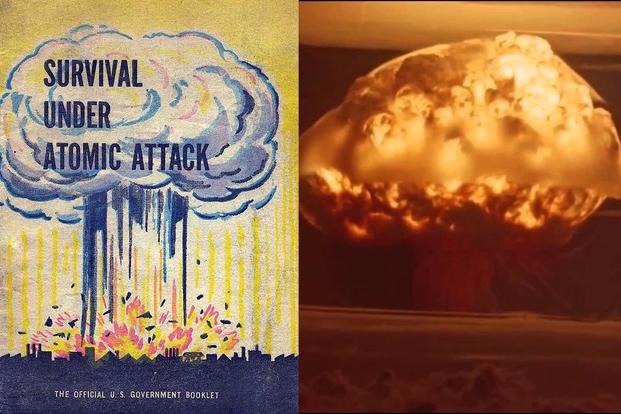
By Logan Nye
A sudden flash. A mushroom cloud. A sudden expanding pressure wave. In the event of a thermonuclear attack, seeing these things means its probably too late to survive. So the U.S. developed warning systems to give Americans a heads up before the bombs landed. But that begs the question: What do you do if you have just an hour or so until your city blows up?
Coordinating protection and relief for civilians in war falls to civil defense workers, and America’s civil defense program underwent an overhaul after World War II. Many of the funding and legislative changes were focused on responding to atomic and nuclear threats.
But hearings in 1955 revealed that civil defense was, uh, let’s say, far from robust. How far?
Well, Administrator Val Peterson told Congress that Americans should learn to dig holes in the ground and curl up in them to escape nuclear fallout. But he did also offer that the government could dig trenches next to highways for about $0.25 per mile and then cover the trenches with boards and soil for additional protection. In some areas, the boards and dirt could be replaced with tar paper.
Even at the time, the public realized a huge shortcoming of this plan: Ditches don’t last. They have to be dug for a specific attack, and the diggers would need at least a few days notice to provide shelter for a significant portion of a city.

And people in the 1950s were also familiar with pissing and pooping. These trenches would have no sanitation, water, or food, and people would have to stay in them for days. At the time, it was believed that a few days might be enough time for the radioactivity to fall to safe-ish levels. We now know it’s a year or more for the longer-lasting radioactive isotopes to get anywhere near safe.
But meanwhile, even a few days in trenches is problematic. For the first few hours, radiation is at peak strength, and any dust that makes its way from the surface into the trench is going to have levels of radiation high enough to threaten imminent death. This dust needs to be washed off as quickly as possible, something that can’t happen in a trench surrounded by more radioactive dust with no water.
Oh, and, btw, canned food and bottled water will become irradiated if not shielded when the bomb goes off.
But there was another plan that, um, had many of the same problems. This called for laying long stretches of concrete pipe and then burying it in a few feet of dirt. Same sanitation and supply problems, worst claustrophobia. But at least less irradiated dust would make it into the civilians huddling inside.
Most of this information was learned by the public in 1955 during those public hearings. Though, obviously, portions of the hearings were classified, and so the public wouldn’t learn about them for decades. One of the items that came out in closed session was that the irradiated zone from a hydrogen bomb would easily stretch for 145 miles with the right winds. A serious problem for the farmers who thought they were safe 40 miles from the city.
Things did get better as the Cold War continued, though. Government agencies, especially the Federal Civil Defense Administration, encouraged the construction of hospitals and other key infrastructure on the perimeters of cities where it would be more likely to survive the blast of a bomb (though it still would have certainly been irradiated if downwind of the epicenter).
Educational videos gave people some idea of what they should do after a bomb drop, though, like digging trenches next to highways, most of the actions an individual could take were marginal at best. Those old “Duck and Cover” cartoons from 1951? Yup, ducking and covering will help, but not enough to save most people at most distances from the bomb.
What you really need to do is find a nice, recently dug trench.





